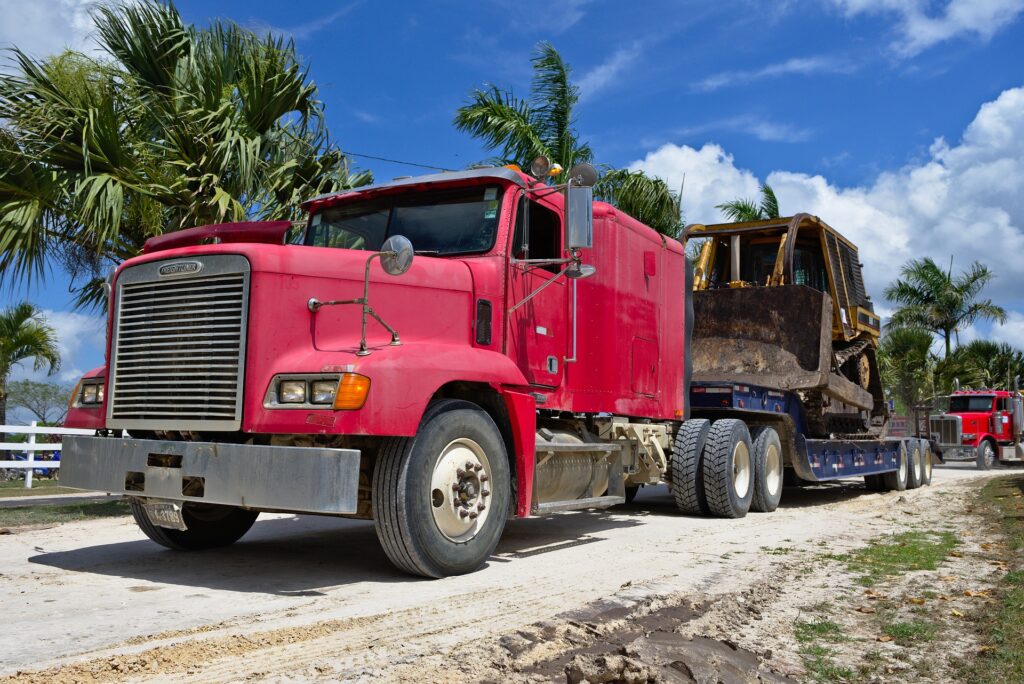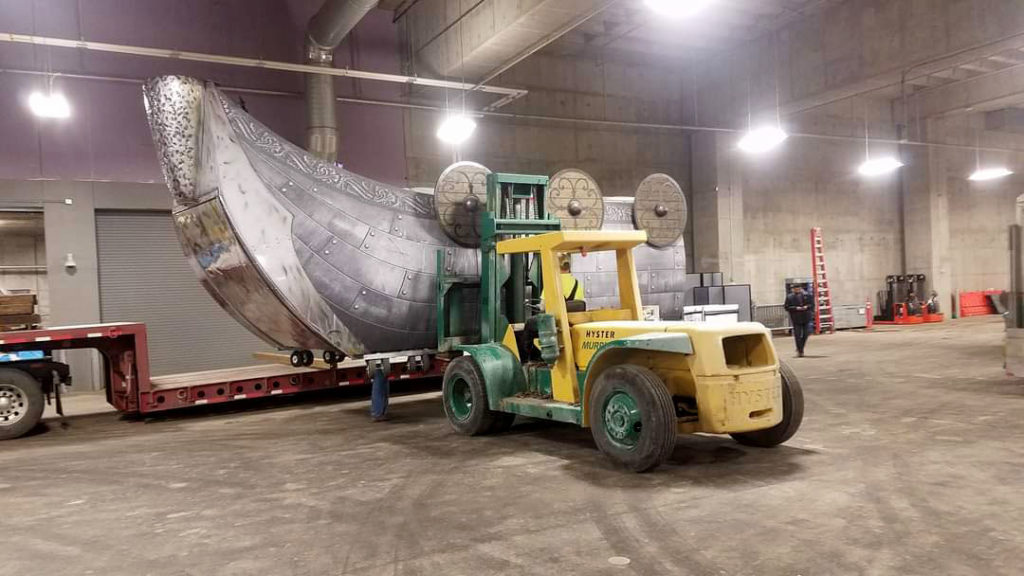
Equipment Transport Machinery Mover
Expert Machinery Mover for Heavy Equipment Transport
Murphy Rigging and Erecting has been the premier machinery mover and equipment hauling company in Minnesota for decades. We specialize in heavy equipment transport for everything from standard pallet-sized commodities all the way up to heavy haul and oversized loads.
Our specialized machinery movers are able to handle the most difficult rigging and logistics projects in any environment. We haul locally and nationally, using all air-ride equipment to protect your valuable machinery during a single machine move or entire plant relocation.
It’s crucial to take all the necessary precautions while transporting a piece of equipment to a job site, whether it’s across the block or across the state. It’s simple for job site safety to take center stage in the construction industry.
Heavy cargo and construction equipment transport is a difficult undertaking that must be done safely and legally. Having a set loading, transportation, and unloading process is not just a best practice when handling some of the largest pieces of machinery, but it is also the only safe way to ensure success. We take care to follow these recommendations for transporting construction equipment safely.
Although loading, securing, and unloading your heavy equipment are equally critical, job site safety before the trip is extremely important as well. Failure to fasten your equipment securely for transport can have serious repercussions, including harm to the equipment and the vehicle you’re using to transport it.
This is why we take so many precautions to ensure safety in our shipping solutions. This allows us to avoid fines for violations, vehicles that are no longer in service, and even harm or fatality to the driver and other parties who may be involved in an accident. As you expert machinery mover, we will ensure your project is an overwhelming success.

Transporting Heavy Equipment
Because loading and unloading heavy equipment accounts for roughly half of all injuries, safety precautions must be adopted from the start to reduce liability and prevent workplace injuries when you are engaged in transport services. As a professional machinery mover, we’re experienced in doing all of the necessary things that make a difference when performing heavy load transport.
Risk Assessment
Companies are accountable for ensuring their own adherence to policies and regulations when it comes to heavy equipment transport liability. Risk assessments are proactive compliance records that let you demonstrate how thorough and in-depth your fleet management procedures are. They include the entire operation and transportation timeline and its weight loads, as well as pertinent project dangers and everything that has been done to address them.
The expert machinery mover team at Murphy Rigging can help you with this process to make sure everything is done correctly, including the coordination with a pilot car and the acquisition of special permits so your heavy load move is compliant.
Inspecting Equipment
Checking the items that will be performing the actual transport comes next in the preparation process for heavy equipment transport. Your vehicle or trailer should be thoroughly inspected for the following things:
Weight: We verify that the total of the working load limits for your tie-downs is at least half as much as the weight of your load.
Tires: We check the tires on all trucks and trailers for damage and pressure. Tire air pressure is negatively impacted by multi-ton machines.
Brakes: Large loads affect how well heavy haul transport vehicles can brake, similarly to how worn tires can impact safety. We ensure that all brake systems and parts are in good working order before anything is moved.
Lights: There shouldn’t be any issues with the lights on vehicles, whether they be on the front or brake lights.
Restraints: We make sure to check the needed number of tie-down points, including the spacing, and the state of the securement on all loads. For large loads weighing more than 10,000 pounds, the majority of states’ regulations require a minimum of four tie-down points, each with a separate boomer or binder and a chain that is attached to a specific trailer hitch point. Since these boomers are in charge of providing the stress needed to tighten the actual chain connection, they must be inspected.
Although the majority of states demand four tie-down points, some heavy equipment needs even more. There must be a minimum of five tie-down points for each machine that has attachments or appendages, and those attachments must be disengaged and secured separately. One typical example of this is when transporting excavators safely.
Driving the heavy equipment shipment up the ramp, attaching a few chains, and sending it on its way are not the only steps in safe loading and heavy equipment hauling. There are a few more things to think about to make sure you transport heavy freight safely and lawfully. As you trusted machinery mover, Murphy Rigging makes sure all safety procedures are followed with our heavy haulers to guarantee successful equipment transport.

Budgeting for Heavy Equipment Hauling Costs
It can be challenging to provide a precise estimate of the cost of heavy equipment shipping due to the numerous elements at play. There are several things to consider when looking for a heavy hauler partner, and taking these into account will allow us to provide the estimate you need.
Here are some more equipment transport factors, besides distance, that may have an impact on the price quote you receive:
Start and End Locations: Urban and densely populated areas are generally less expensive as they are closer together and require less travel time and fuel. The further away from major thoroughfares your pick-up or delivery destination may be, you can expect a slightly increased cost.
Timeframe: It’s possible that heavy equipment hauling costs may be higher if you need items delivered in a rushed timeframe. Allowing for deliveries within normal delivery schedules can keep costs down, as they do not require extra manpower, hours, or effort.
Equipment Size: The size of the heavy machinery you need to transport will also have an impact on the cost. The most common method is flatbed hauls, which are enough for the majority of big, bulky things. In the extremely unlikely event that you need more than a flatbed, specialty trailers may be used, which may require specific licenses and can enhance your cost. Because of the item’s size, some paths might not be accessible, which could result in a lengthier journey, also increasing costs.
3rd party Costs: Depending on where your equipment transport project takes you, you may need a pilot car, special permits, and even law enforcement escorts.
Weather and Seasons: In some situations, bad weather can have an impact on prices because it might close roads and lengthen travel times.
Planning Your Heavy Equipment Hauling Project
There is clearly much to remember when it comes to your heavy equipment transport. That doesn’t mean you should fear the process. The knowledgeable staff at Murphy Rigging is there to assist you when it comes time to move your track loader, crane, generator, compactor, or other large machines. We work with you to obtain any of the special permits you will need to properly transport equipment.
There is a lot to deal with in heavy equipment hauling, but rest assured that we have you covered. Let the Murphy Rigging team deal with everything for you so you can know your equipment will be handled professionally from beginning to end.
Frequently Asked Questions
Equipment transportation involves safely moving large machinery, cargo, equipment, and devices between two or more locations. This can be from a manufacturer’s facility to the end customer’s location. It can be for relocating equipment within a facility or to a new facility or location. It may involve securing permits or support from local authorities. A reputable machinery mover is experienced in handling all of these things.
Using a professional company like Murphy Rigging for equipment transport offers several advantages. They have the experience and expertise to plan the most efficient route, ensuring a safe arrival at the destination. They possess the proper permits to handle and transport oversized or heavy loads, or know how to secure them. A professional machinery mover will also own or have access to the specialized equipment required to handle oversized or heavy loads. They have experience with similar projects and know what to expect during equipment transport.
A professional rigging company will be able to guide you in preparing for heavy equipment hauling. As an expert machinery mover, we will be able to give you clear instructions on how to clean equipment, remove unnecessary fluids, secure loose parts or materials, and limit or eliminate potential damage during transport.
There are often permits required for heavy equipment hauling. These may be at the local city, county, or state level. There may also be federal requirements, depending on the loads being transported. An expert machinery mover such as Murphy Rigging will know what is required and how to successfully obtain permits.
Rigging involves lifting, placing, and securing equipment during loading, unloading, or at the job site. Heavy equipment transport, by comparison, involves moving equipment, machinery, or large loads from one location to another. Murphy Rigging provides both services, making it simple to address both with one reliable partner.
